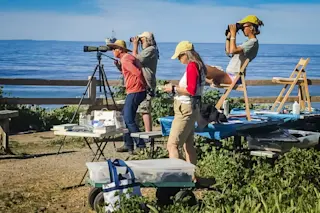A group of Gray Whales Count volunteers count gray whales at Coal Oil Point in Santa Barbara. (ianvorsterphotography.com) It was a crisp morning following a cold night in Goleta’s Coronado Monarch Butterfly Preserve. As Luke crossed a beam that had been dropped across a swampy area, he looked up at the Eucalyptus grove and sighed quietly. “Where are the butterflies Dad,” he asked me—with one part expectation and one part disappointment. “They’re meant to be roosting up there in the leafy branches,” I motioned before adding, “hopefully.” But we didn’t immediately see any monarchs in the trees—instead we noticed a few on the ground, here and there. Our eyes became accustomed to the early morning gloom, and we realized an inordinate number of brightly colored insects were scattered on the ground throughout the grove. As we walked and photographed them, stepping carefully, I realized why so many were to be ...
Journey North: Tracking the Stories of Survival with Citizen Science
Join the Gray Whales Count effort! Discover how citizen science tracks gray whales and migratory species like monarchs.
More on Discover
Stay Curious
SubscribeTo The Magazine
Save up to 40% off the cover price when you subscribe to Discover magazine.
Subscribe













